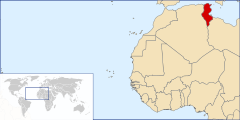
Bizerte is a city of Bizerte Governorate in Tunisia. It is the northernmost city in Africa, located 65 km (40 mi) north of the capital Tunis. It is also known as the last town to remain under French control after the rest of the country won its independence from France. The city had 162,053 inhabitants in 2014.

Monastir, also called Mestir, is a city on the central coast of Tunisia, in the Sahel area, some 20 kilometres south of Sousse and 162 kilometres south of Tunis. Traditionally a fishing port, Monastir is now a major tourist resort. Its population is about 93,306. It is the capital of Monastir Governorate.

Gabès, also spelled Cabès, Cabes, Kabes, Gabbs and Gaps, is the capital city of the Gabès Governorate in Tunisia. It is located on the coast of the Gulf of Gabès. With a population of 167,863, Gabès is the 6th largest Tunisian city. Gabes is 327 km away from Tunis and 113 km away from Sfax.

Béja is a city in Tunisia. It is the capital of the Béja Governorate. It is located 105 kilometers (65 mi) from Tunis, between the Medjerdah River and the Mediterranean, against the foothills of the Khroumire, the town of Béja is situated on the sides of Djebel Acheb, facing the greening meadows, its white terraces and red roofs dominated by the imposing ruins of the old Roman fortress.

Gafsa is the capital of Gafsa Governorate of Tunisia. With a population of 120,739, Gafsa is the ninth-largest Tunisian city and it is 335 kilometers from the capital Tunis.

Zaghouan is a town in the northern half of Tunisia.

Sfax is a city in Tunisia, located 270 km (170 mi) southeast of Tunis. The city, founded in AD 849 on the ruins of Berber Taparura, is the capital of the Sfax Governorate, and a Mediterranean port. Sfax has a population of 341,999. Its main industries include phosphate, olive and nut processing, fishing and international trade. The city is the second-most populous in the country after the capital, Tunis.

Medenine is the major town in south-eastern Tunisia, 77 kilometres (48 mi) south of the port of Gabès and the Island of Djerba, on the main route to Libya. It is the capital of Medenine Governorate.

Jendouba is a city in northwestern Tunisia, and capital of the Jendouba Governorate. It is an important crossroads with many road links to other towns such as El Kef, Tabarka, Ain Draham and Béja. The main economic activity is agriculture. It is close to the famous ancient Roman city of Bullaregia or Bulla Regia, as well as the ancient marble quarry of Chemtou. The city's name is derived from Amazigh with the exact translation being “land of grain.”

Nabeul is a coastal town located in northeastern Tunisia, on the south coast of the Cape Bon peninsula and surrounded by the Mediterranean Sea on both sides. It is the first seaside resort in Tunisia. It is known for its agricultural riches and its tourism potential. The city had a population of 84,291 as of the 2022 census.

El Kef, also known as Le Kef, is a city in northwestern Tunisia. It serves as the capital of the Kef Governorate.
Kelibia (Kélibia), often referred to as Klibia or Gallipia by European writers, is a coastal town on the Cap Bon peninsula, Nabeul Governorate in the far north-eastern part of Tunisia. Its sand beaches are considered some of the finest in the Mediterranean.
Remada is a municipality in Tunisia, close to the border with Libya. It is located at around 32°18′22″N10°22′56″E. Remada was built as a garrison town by the French and is today home to a Tunisian military base.

Kebili is a town in the south of Tunisia and one of the main cities in the Nefzaoua region. It is located in southern Tunisia near the Chott el Djerid salt lake. It is the capital of the Kebili Governorate.

Sidi Bouzid, sometimes called Sidi Bou Zid or Sīdī Bū Zayd, is a city in Tunisia and is the capital of Sidi Bouzid Governorate in the centre of the country. Following the suicide of Mohamed Bouazizi in Sidi Bouzid, it was the site of the first clashes of the Tunisian Revolution and a catalyst for other protests in the region, often known as the Arab Spring.

Siliana is a modern farming town in northern Tunisia. It is located at around 36°4′55″N9°22′29″E, 130 km south-west of the capital Tunis. It is the capital of the Siliana Governorate. It is located 4 miles away from Jama where the Battle of Zama occurred.

Menzel Bourguiba, formerly known as Ferryville, is a town located in the extreme north of Tunisia, about 60 kilometres (37 mi) from Tunis, in the Bizerte Governorate.

Thala is a town and commune in Tunisia. It is located in the Kasserine Governorate since 1956. As of the 2004 census it had 13,968 inhabitants. The altitude of Thala is 1,017 metres (3,337 ft), which makes it the highest and the coldest town in the country.

Borj El Amri or Bordj El Amri is a town in the Manouba Governorate of Tunisia. It is located 30 kilometres (19 mi) southwest of Tunis.

El Borma is a town and commune, which is coextensive with El Borma District, in Algeria. According to the 2008 census it has a population of 3,250, up from 1,997 in 1998 and an annual population growth rate of 4.9%, the second highest in the province. The town is located on the border with Tataouine Governorate, Tunisia.























